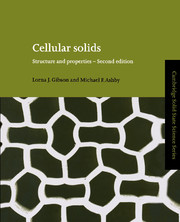Book contents
- Frontmatter
- Contents
- Preface to the second edition
- Preface to the first edition
- Units and conversion tables
- Chapter 1 Introduction
- Chapter 2 The structure of cellular solids
- Chapter 3 Material properties
- Chapter 4 The mechanics of honeycombs
- Chapter 5 The mechanics of foams: basic results
- Chapter 6 The mechanics of foams: refinements
- Chapter 7 Thermal, electrical and acoustic properties of foams
- Chapter 8 Energy absorption in cellular materials
- Chapter 9 The design of sandwich panels with foam cores
- Chapter 10 Wood
- Chapter 11 Cancellous bone
- Chapter 12 Cork
- Chapter 13 Sources, suppliers and property data
- Appendix: The linear-elasticity of anisotropic cellular solids
- Index
Preface to the second edition
Published online by Cambridge University Press: 05 August 2014
- Frontmatter
- Contents
- Preface to the second edition
- Preface to the first edition
- Units and conversion tables
- Chapter 1 Introduction
- Chapter 2 The structure of cellular solids
- Chapter 3 Material properties
- Chapter 4 The mechanics of honeycombs
- Chapter 5 The mechanics of foams: basic results
- Chapter 6 The mechanics of foams: refinements
- Chapter 7 Thermal, electrical and acoustic properties of foams
- Chapter 8 Energy absorption in cellular materials
- Chapter 9 The design of sandwich panels with foam cores
- Chapter 10 Wood
- Chapter 11 Cancellous bone
- Chapter 12 Cork
- Chapter 13 Sources, suppliers and property data
- Appendix: The linear-elasticity of anisotropic cellular solids
- Index
Summary
The ten years since the first edition of this book appeared have seen a remarkable increase in interest in cellular solids. New techniques for making ceramic and metallic foams have widened the range of man-made materials and the diversity of their applications; and the continued interest in wood, cork, and cancellous bone has stimulated new experiments and models to characterise natural cellular structures. This second edition was stimulated by these developments and by the very diverse community of enthusiastic scientists and engineers who have contacted us to discuss aspects of the structure and properties of cellular solids. Each chapter of the first edition has been extensively revised and brought up to date, but this, we found, was not enough. Techniques for making foams are more fully described; recent work on the mechanical response of solid foams to multiaxial loading, to deformation under creep conditions, and to impact loading have required new sections; acoustic properties are included for the first time; and there is a new chapter on the selection of foams to meet specified design criteria and on data sources and databases for foam properties.
As with the first edition, we have been greatly helped by many generous colleagues and friends.
- Type
- Chapter
- Information
- Cellular SolidsStructure and Properties, pp. xi - xiiPublisher: Cambridge University PressPrint publication year: 1997
- 1
- Cited by

